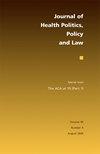Introduction: Investigating Dimensions of Pandemic Inequity Requires a Multidisciplinary Approach.
IF 3.3
3区 医学
Q1 HEALTH CARE SCIENCES & SERVICES
引用次数: 0
Abstract
When the coronavirus emerged in the United States in early 2020, reassuring early platitudes suggested that “we are all in this together” and “COVID-19 is an equal opportunity killer” (see, e.g., Blow 2020; Reuters 2020). These platitudes quickly became exposed as such, however, as evidence demonstrating the unequal reach and consequences of the pandemic accumulated. Data on the epidemiologic impact—combined with the everyday experiences of the most affected groups in the United States—continue to reinforce the reality that this pandemic is inequitable in almost every imaginable dimension. According to March 2021 data from the Color of Coronavirus project, the highest overall rates of death are among Indigenous Americans (256 deaths per 100,000), followed by Black Americans (180 deaths per 100,000); once accounting for age, Pacific Islanders and Latinos have the highest mortality rates (APM 2021). Coronavirus-related concern is also unequally distributed by race, with only 17% of white respondents to a Pew survey in late 2020 saying they were very concerned about getting COVID-19, while 37% of Hispanic and 36% of Black respondents reported the same (Pew 2020). Furthermore, 71% of Black respondents in the same poll reported they knew someone who had been hospitalized or died as a result of COVID-19, compared to 49% of white respondents (Pew 2020). Higher viral exposure through high-risk workplaces (e.g., meatpacking), living in crowded housing conditions (including long-term care and carceral settings), and inability to work from home—combined with heightened vulnerability to more serious illness because of chronic conditions borne from compounded risks of structural前言:调查流行病不平等的各个方面需要多学科的方法。
本文章由计算机程序翻译,如有差异,请以英文原文为准。
求助全文
约1分钟内获得全文
求助全文
来源期刊
CiteScore
7.30
自引率
7.10%
发文量
46
审稿时长
>12 weeks
期刊介绍:
A leading journal in its field, and the primary source of communication across the many disciplines it serves, the Journal of Health Politics, Policy and Law focuses on the initiation, formulation, and implementation of health policy and analyzes the relations between government and health—past, present, and future.

 求助内容:
求助内容: 应助结果提醒方式:
应助结果提醒方式:


